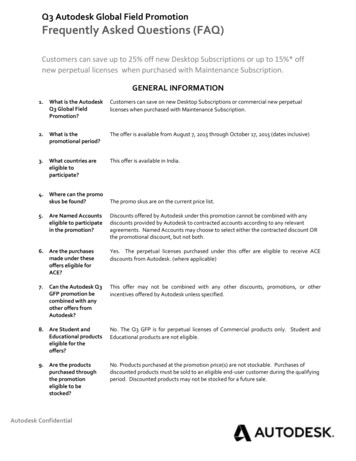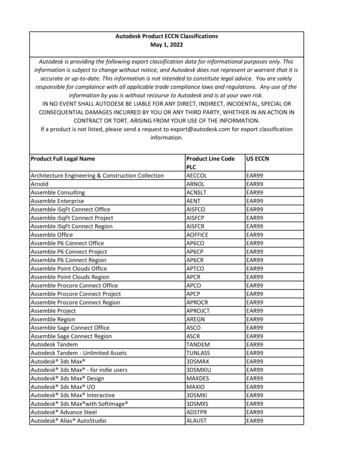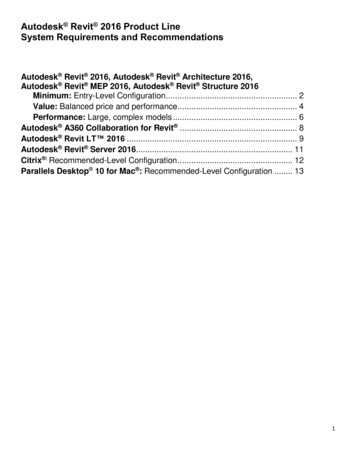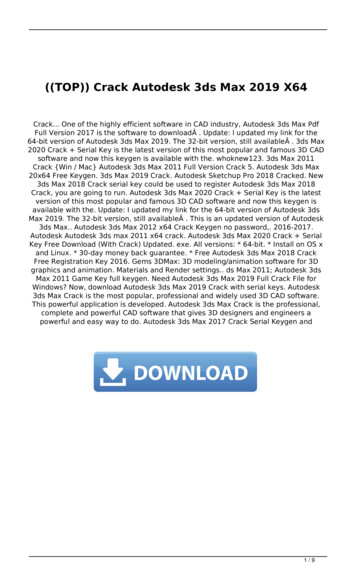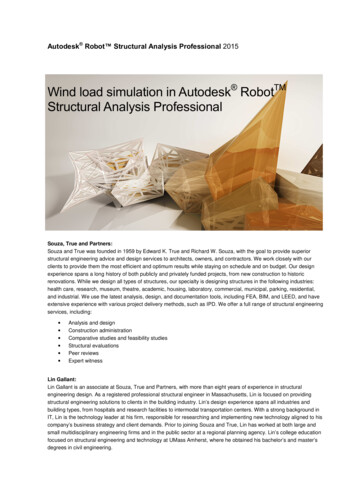
Transcription
Autodesk Robot Structural Analysis Professional 2015Wind load simulation in Autodesk RobotTMStructural Analysis ProfessionalSouza, True and Partners:Souza and True was founded in 1959 by Edward K. True and Richard W. Souza, with the goal to provide superiorstructural engineering advice and design services to architects, owners, and contractors. We work closely with ourclients to provide them the most efficient and optimum results while staying on schedule and on budget. Our designexperience spans a long history of both publicly and privately funded projects, from new construction to historicrenovations. While we design all types of structures, our specialty is designing structures in the following industries:health care, research, museum, theatre, academic, housing, laboratory, commercial, municipal, parking, residential,and industrial. We use the latest analysis, design, and documentation tools, including FEA, BIM, and LEED, and haveextensive experience with various project delivery methods, such as IPD. We offer a full range of structural engineeringservices, including: Analysis and designConstruction administrationComparative studies and feasibility studiesStructural evaluationsPeer reviewsExpert witnessLin Gallant:Lin Gallant is an associate at Souza, True and Partners, with more than eight years of experience in structuralengineering design. As a registered professional structural engineer in Massachusetts, Lin is focused on providingstructural engineering solutions to clients in the building industry. Lin’s design experience spans all industries andbuilding types, from hospitals and research facilities to intermodal transportation centers. With a strong background inIT, Lin is the technology leader at his firm, responsible for researching and implementing new technology aligned to hiscompany’s business strategy and client demands. Prior to joining Souza and True, Lin has worked at both large andsmall multidisciplinary engineering firms and in the public sector at a regional planning agency. Lin’s college educationfocused on structural engineering and technology at UMass Amherst, where he obtained his bachelor’s and master’sdegrees in civil engineering.
Wind Load Simulation in Autodesk Robot Structural Analysis ProfessionalContentsIntroduction .3Present solutions: analytical methods and wind tunnel testing .4A new wind simulation solution: Robot Structural Analysis Professional .5Conclusions .82
Wind Load Simulation in Autodesk Robot Structural Analysis ProfessionalIntroductionAccurately capturing wind load effects on tall buildings and complex structures presents structural engineers withdifficult design challenges. In the United States, most building codes require that designers adhere to the windload provisions of ASCE 7, with most states currently referencing either ASCE 7-05 or ASCE 7-10. Othercounties have similar codes, or reference ASCE 7 for wind design. While there are significant differencesbetween the two versions, they each offer three wind load analysis methods for engineers to use: two analyticalmethods and one testing method. The two analytical methods, one simplified and one more detailed, allowengineers to calculate wind pressures quickly using tables, figures, and equations. However, the use of theanalytical methods is limited to structures with specific geometric and response characteristics. For buildings andstructures that fall outside these limitations, the code allows wind tunnel testing, which requires engaging theservices of a wind consultant. Choosing which of these methods to implement is a decision that should be madeearly in the design process. For tall structures and complex structures, this decision requires engineers tobalance design accuracy, safety, and efficiency with impacts to workflow.3
Wind Load Simulation in Autodesk Robot Structural Analysis ProfessionalPresent solutions: analytical methods and windtunnel testingThe analytical methods presented in ASCE 7 are suitable for capturing against-wind load effects for low-rise and midrise buildings with standard shapes, surroundings, and response characteristics, and in these cases are relativelyeasy to implement. However, for buildings that fall outside these parameters, it can be difficult to apply eitheranalytical method, and the results can vary considerably from reality. This is because the equations, tables, andfigures used by each method were derived from test results for simple (rectangular) building shapes, and representthe upper envelope of values for those tests. These methods do not account for: aerodynamic effects for irregularshaped structures and building protrusions (balconies, fins, etc.); the influence of adjacent structures and topography;or aeroelastic interactions between wind flow and the motion of the structure, such as vortex shedding, galloping, andflutter. In addition, they offer limited guidance on torsional loading effects. Compared to testing results, analyticalresults for tall and complex structures have been generally shown to produce higher along-wind loading pressures onthe overall structure, which can lead to overly conservative designs. Analytical results have also been shown tounderestimate along-wind loading pressures on localized regions and components, which can lead to unconservativedesigns of cladding and supporting elements. Furthermore, the analytical methods don’t account for aeroelasticinteractions, which can induce larger building responses than against-wing loading. For complex structures, ASCE 7recognizes these deficiencies and requires that engineers design according to recognized literature or use the resultsof wind tunnel testing.Figure 1. Wind tunnel and model—view from northwest.In a wind tunnel test, direct measurements of wind pressures on a structure are obtained by subjecting ageometrically scaled model of a structure, and its surroundings, to a simulated wind environment. Wind consultantsare able to use wind tunnel data and postprocessing to account for aerodynamic effects of the actual building shape,the influence of nearby structures and topography, the local wind climate, and aeroelastic building response. Resultsobtained from instrumented full-sized structures, subject to design-level wind speeds, have shown wind tunnel testresults are more accurate than analytical method results. These results can be more refined and focus on projectspecific concerns, which allows for the potential of safer, better performing, and more cost-effective designs. Windstudies can also investigate other design concerns, such as occupant comfort, the outdoor wind comfort ofpedestrians, air-quality impacts of building exhaust, and more. However, hiring a wind consultant does have both anupfront cost and workflow impacts that must be considered.4
Wind Load Simulation in Autodesk Robot Structural Analysis ProfessionalGenerally, hiring a wind consultant to conduct wind tunnel tests is expensive (tens of thousands of dollars), a cost thatis dependent on the number and type of tests and level of postprocessing analysis. The willingness of clients to makethis upfront investment is not always an easy proposition. The upfront cost of hiring a wind consultant can be offset bycost savings from design efficiencies achieved from the results, and can be further rationalized by increases in safetyand occupant comfort. For the design team, there are also workflow challenges. The design team must be aware ofthe complexities that arise from adding another consultant to the project team, in determining their scope of work andin weaving their testing schedule into the overall project schedule. Since many of the most important form andfunction decisions occur early in the design process, it is advantageous to determine what impact wind design is goingto have on the structure as early as possible. Engaging a wind consultant early in the process is clearly desirable froma results standpoint, but has cost implications (additional testing) and might not be feasible within the projectschedule. Alternatively, designers can use the analytical procedures from ASCE 7 for preliminary design purposes,but, as discussed previously, those results could be unrealistic. What engineers need is a wind simulation tool thatconsiders all wind load effects and is easy and cost-effective to use in the early stages of design. Companies thatspecialize in wind analysis use computer analysis tools, but the software is typically complex, proprietary, and notcommercially available. What engineers need is a commercially available structural analysis and design program withwind simulation capabilities.5
Wind Load Simulation in Autodesk Robot Structural Analysis ProfessionalA new wind simulation solution: Robot StructuralAnalysis Professional TMWith the release of Autodesk Robot Structural Analysis Professional 2015 software, Autodesk incorporates apowerful new wind simulation tool into the software that enables users to emulate wind tunnel testing to investigatebuilding performance. By incorporating computational fluid dynamics (CFD) analysis capabilities into Robot StructuralAnalysis Professional, users will be able to quickly subject their structures to simulated wind flows. The analysis canbe customized and the results can be viewed or used to automatically generate wind loads on the structure. RobotStructural Analysis Professional’s wind simulation analysis is unique to structural analysis and design software, and isapplicable to all structure types. Unlike code-based analytical methods, the program accounts for the actual buildinggeometry and the interaction between wind flow and building response. As building parameters change, such asgeometry, mass, or stiffness, the engineer can quickly update the wind analysis and see the results of these changes.Preliminary validation testing has revealed that Robot Structural Analysis Professional’s wind simulation resultsclosely match those from the code-based analytical methods, for regular-shaped, low-rise structures, and wind tunnelresults for more complex structures. Autodesk has made available a validation study of wind tunnel testing so userscan understand the results the simulation will provide for them. Additional validation tests are proposed for a widevariety of structure types, so designers can be confident that the wind simulation results are accurate for allapplications.Figure 2. Wind parameters in Robot Structural Analysis Professional6
Wind Load Simulation in Autodesk Robot Structural Analysis ProfessionalConducting a wind simulation analysis in Robot Structural Analysis Professional is both fast and easy. Once themodel has been built, the user simply engages the wind simulation command and begins defining the analysisparameters. The Wind Simulation dialog box enables the user to adjust various wind simulation parameters, including:wind direction; wind velocity (or a uniform pressure); terrain elevation; load generation requirements; and the windprofile along the height of the building, which allows for different wind exposure simulation. These parameters enablethe user to customize his or her analysis to fit the building and site characteristics. Once the analysis is started, theuser will see the wind pressure results from the wind flow analysis, updated in real time, as the analysis progresses.Once the analysis is complete, either by converging to a set tolerance or as dictated by the user, the user can havethe program automatically generate and apply equivalent static loads from the simulation results to the structuralmembers.Figure 3. The terrain category wind profile was translated into several points used to input a velocity profile into the RobotStructural Analysis Professional wind simulation tool.A typical wind simulation takes only a few minutes to complete, which is a significant time savings over either theanalytical or wind tunnel testing methods. Because of this speed and ease of implementation, Robot StructuralAnalysis Professional’s wind simulation will enable engineers to determine wind load effects earlier in the designprocess, without compromising accuracy or waiting for results from an outside consultant. Predicting wind load effectsearly in design can reveal detrimental wind-induced building responses—before structural system changes become asurprising and costly redesign issue. This provides the design team with the ability to quickly investigate the impact ofdesign decisions, creating a unique and iterative approach to wind design. Robot Structural Analysis Professional’swind simulation capabilities can help augment analyticalmethods and physical testing early in the designprocess—prior to the application of coderecognized methods for wind design—offeringsignificant advantages when it comes to projectunderstanding and fast project iteration.7
Wind Load Simulation in Autodesk Robot Structural Analysis ProfessionalConclusionsWind load effects on tall or geometrically complicated buildings and complex structures such as masts, truss towers,and industrial platforms can be challenging to account for accurately and can create complex workflows for the designteam. The code-based wind design methods offer designers three approaches to capture these effects, but eachmethod has limitations and trade-offs between accuracy and cost. The analytical methods suffer from limitations onapplicability and accuracy, and wind tunnel testing comes at a cost and with impacts to workflow. Robot StructuralAnalysis Professional’s wind simulation can supplement each method and address some of their shortcomings, evenbefore the application of code-recognized methods for wind design. Engineers can use this software to validate orsupplement analytical method results, and to identify potential wind design issues that require special considerationearlier in the design process. Robot Structural Analysis Professional can replace wind tunnel testing during the earlydesign stages, providing meaningful results much more quickly and at a much lower cost. The software can’t replaceall wind tunnel test types, such as occupant comfort or outdoor pedestrian comfort; however, it can be used tosupplement, validate, and investigate wind tunnel test results, and perhaps to reduce the number of tests required.This can help save engineering time, reduce wind consultant costs, and shrink overall project costs. The softwareprovides a unique approach to wind simulation and load generation that cannot be found in other structural analysisand design software. Robot Structural Analysis Professional’s wind load simulation is a robust tool that improves afirm’s wind design capabilities, at a cost much lower than a single wind tunnel test, and provides many other usefulanalysis and design features.Figure 4. Wind load simulation tool in action in Robot Structural Analysis Professional.Autodesk, the Autodesk logo, and Robot are registered trademarks or trademarks of Autodesk, Inc., and/or its subsidiaries and/or affiliates in theUSA and/or other countries. All other brand names, product names, or trademarks belong to their respective holders. Autodesk reserves the rightto alter product and services offerings, and specifications and pricing at any time without notice, and is not responsible for typographical orgraphical errors that may appear in this document. 2014 Autodesk, Inc. All rights reserved.8
Autodesk Robot Structural Analysis Professional 2015 Wind load simulation in Autodesk Robot TM Structural Analysis Professional Souza, True and Partners: Souza and True was founded in 1959 by Edward K. True and Richard W. Souza, with the goal to provide superior

